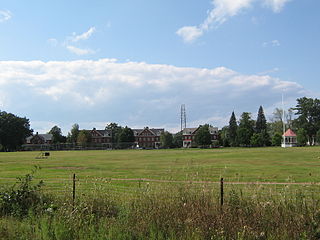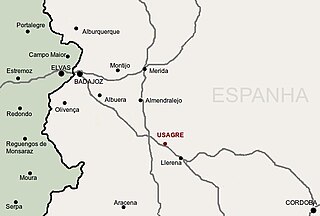Related Research Articles

The Gardes du Corps was the personal bodyguard of the king of Prussia and, after 1871, of the German emperor. The unit was founded in 1740 by Frederick the Great. Its first commander was Friedrich von Blumenthal, who died unexpectedly in 1745; his brother Hans von Blumenthal, who, with the other officers of the regiment had won the Pour le Mérite in its first action at the battle of Hohenfriedberg, assumed command in 1747. Hans von Blumenthal was badly wounded leading the regiment in a successful cavalry charge in the battle of Lobositz and had to retire from the military.

Fort Ethan Allen was a United States Army installation in Vermont, named for American Revolutionary War figure Ethan Allen. Established as a cavalry post in 1894 and closed in 1944, today it is the center of a designated national historic district straddling the town line between Colchester and Essex. Locally, it is known simply as "The Fort", and now houses a Vermont National Guard installation a variety of businesses, academic institutions, and residential areas.

The Third Army was originally established in Skopje and later defended the northeastern provinces of the Ottoman Empire. Its initial headquarters was at Salonica, where it formed the core of the military forces that supported the Young Turk Revolution of 1908. Many of its officers who participated in the Revolution, including Enver Pasha and Mustafa Kemal Atatürk, rose to fame and power.

In the Battle of Usagre on 25 May 1811, Anglo-Allied cavalry commanded by Major-General William Lumley routed a French cavalry force led by Major-General Marie Victor Latour-Maubourg at the village of Usagre in the Peninsular War.
The 3rd Army Corps was an Army corps in the Imperial Russian Army formed on 19 February 1877.

In the Battle of Campo Maior, or Campo Mayor, on 25 March 1811, Brigadier General Robert Ballard Long with a force of Anglo-Portuguese cavalry, the advance-guard of the army commanded by William Beresford, clashed with a French force commanded by General of Division Marie Victor de Fay, marquis de Latour-Maubourg. Initially successful, some of the Allied horsemen indulged in a reckless pursuit of the French. An erroneous report was given that they had been captured wholesale. In consequence, Beresford halted his forces and the French were able to escape and recover a convoy of artillery pieces.

Established in 1819 as Garde-Landwehr Kavallerie Regiment, they were a light cavalry regiment of Uhlans of the Royal Prussian Army. The regiment was later reorganised as heavy cavalry Uhlans and renamed into 1. Garde Ulanen Regiment (1826) and fought in the Austro-Prussian and Franco-Prussian war. In World War I the regiment was part of the Guards Cavalry Division fighting on the Western and Eastern Front.
The 1st Royal Bavarian Heavy Cavalry “Prince Charles of Bavaria” were a heavy cavalry regiment of the Royal Bavarian Army. The regiment was formed in 1814 as Garde du Corps to the King of Bavaria. The normal peacetime location of the regiment was Munich. The regiment fought in the War of the Sixth Coalition, the Austro-Prussian War, the Franco-Prussian War and World War I. The regiment was disbanded in 1919.
The I Corps of the Ottoman Empire was one of the corps of the Ottoman Army consisting of ethnic Albanians. It was formed in the early 20th century during Ottoman military reforms

The III Corps of the Ottoman Empire was one of the corps of the Ottoman Army. It was formed in the early 20th century during Ottoman military reforms.
The IV Corps of the Ottoman Empire was one of the corps of the Ottoman Army. It was formed in the early 20th century during Ottoman military reforms. It was disbanded at the end of World War I.
The V Corps of the Ottoman Empire was one of the corps of the Ottoman Army. It was formed in the early 20th century during Ottoman military reforms.
The VII Corps of the Ottoman Empire was one of the corps of the Ottoman Army. It was formed in the early 20th century during Ottoman military reforms.
The X Corps of the Ottoman Empire was one of the corps of the Ottoman Army. It was formed in the early 20th century during Ottoman military reforms.
The Vardar Army of the Ottoman Empire was one of the field armies under the command of the Western Army. It was formed during the mobilisation phase of the First Balkan War.
The 2nd Guards Cavalry Division was a Guards light cavalry division of the Imperial Russian Army.
The 2nd Cavalry Division was a cavalry formation of the Russian Imperial Army.
The 7th Cavalry Division was a cavalry formation of the Russian Imperial Army.
Milivoje Čolak-Antić was a Royal Serbian Army officer, most notable for his command of Chetniks volunteer detachments in Macedonia during the Balkan Wars, and his actions with Operation Departments during World War I for which he received multiple awards.
References
- Schulz, Hugo (1992). Die preussischen Kavallerie-Regimenter 1913/1914 nach dem Gesetz vom 3. Juli 1913. Augsburg: Weltbild. p. 178. ISBN 3893503439.